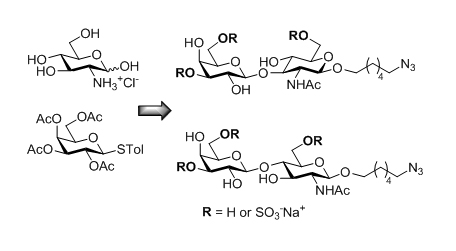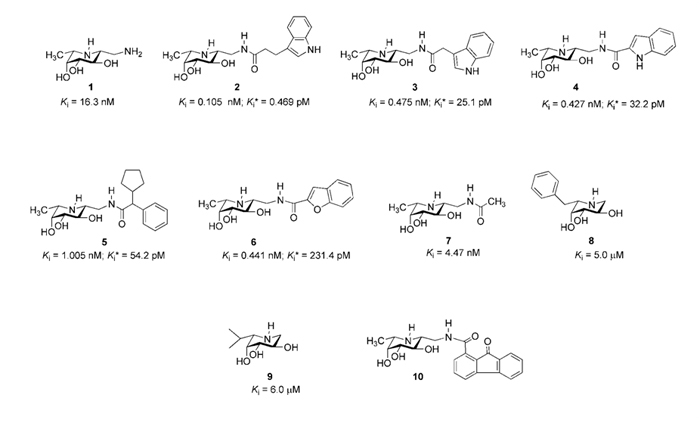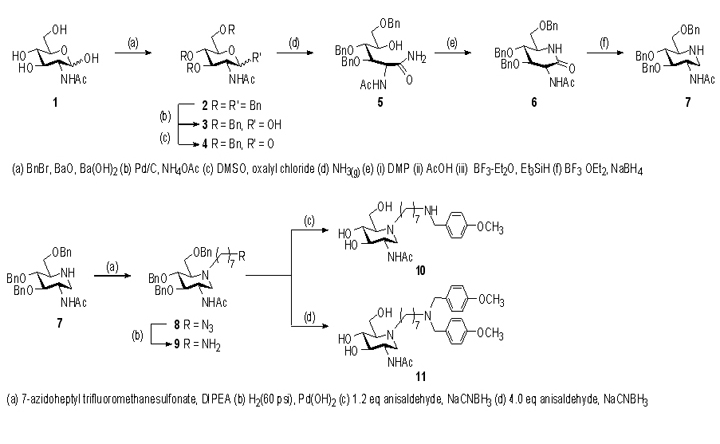|
 |
| |
| °@ |
| Synthesis of Sulfated Sugars |
Sulfate-containing glycans play an important role in a myriad of physiological activities, including cell morphogenesis and development, viral invasion, tumor metastasis, inflammation and neural disorders. It is known that sulfated sugars usually display better activities than non-sulfated homologues. However, the structure and activity relationship of sulfated glycans still remain ambiguous, i.e. it is important to know which specific position of an oligosaccharide needs to be incorporated with a sulfate to enhance the binding interactions with the corresponding receptor/protein. Although several groups have launched their endeavors to prepare these complicated carbohydrates, one critical challenge in this area is to develop an expeditious procedure for introducing sulfate(s) to specific position(s) of oligosaccharides in a systematic manner. So far we have developed a one-pot procedure for preparing a orthogonally protected disaccharide, leading to synthesis of various sulfated and non-sulfated Gal-1,3/4-GlcNAc saccharides. These oligosaccharides have been examined for their physiological activities.
|
 |
| Synthesis of Glycoenzyme Inhibitors |
Human N-acetyl-£]-hexosaminidase (Hex) isozymes are considered to be important targets for drug discovery. They are directly linked to osteoarthritis because Hex is the predominant glycosidase released by chondrocytes to degrade glycosaminoglycan. Hex is also associated with lysosomal storage disorders. We report the discovery of GlcNAc-type iminocyclitiols as potent and selective Hex inhibitors, likely contributed by the gain of extra electrostatic and hydrophobic interactions. The most potent inhibitor had a Ki of 0.69 nM against human Hex B and was 2.5°—105 times more selective for Hex B than for a similar human enzyme O-GlcNAcase. These glycosidase inhibitors were shown to modulate intracellular levels of glycolipids, including ganglioside-GM2 and asialoganglioside-GM2
£\-Fucosidase is associated with many disorders including inflammation, cancer, cystic fibrosis and fucosidosis. The enzyme is released by gastric epithelial cells only upon infection with Helicobacter pylori to affect the bacterial growth, adhesion, and pathogenicity. We report nine X-ray crystal structures in complex with iminocyclitols, which have Ki values spanning the micro- to picomolar ranges and up to 106-fold variation in potency. These inhibitors are C1- to C5- substituted fuconojirimacin derivatives. Some of them show time-dependent, slow-binding inhibition events that undergo progressive tightening of the enzyme-inhibitor complex from a low-nanomolar Ki value to a picomolar Ki *.
|
Fuconojirimycin derivatives |
 |
| Potent and Selective N-Acetyl-£]-Hexosaminidase Inhibitors |
 |
|
°@ |
|
|
Browser & IE Recommendations: 1024*768 / IE 7.0°BFirefox 3.0
Add : 128 Sec. 2, Academia Road, Nankang,Taipei 115,Taiwan°@Tel : 886-2-27855696°@Fax : 886-2-27889759 |
|
Copyright © 2010 IBC. All rights reserved. |
|
 |
![]() |